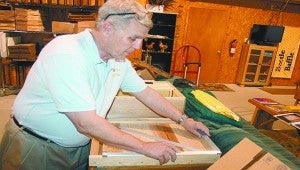Beekeeper invention protects hives
Published 7:00 am Tuesday, March 18, 2014

Haynes Haselmaier shows how simple it is to install his invention, which protects beehives from the invasive and destructive small hive beetle
Local beekeeper, Hayne Haselmaier, has invented a device, the Beetle Baffle, which helps protect bee colonies from invasive small hive beetles.
The device is made of thin strips of aluminum that keeps the beetles at the bottom of the hive, ensuring the destructive insect cannot cause permanent damage.
Haselmaier said when the beetles enter a hive they head straight for the honey and begin to lay eggs in the hive. The eggs will hatch, and their larvae will eat holes through the comb, causing the honey to leak out of the comb and eventually cause the honey to ferment due to yeast the beetles carry.
His $16 kit installs on the bottom of movable frame hives. The metal strips protrude into the bottom of the hive and prevent the beetle from climbing up to where the honey is produced. Instead the beetles are forced to feed on what has fallen to the bottom of the hive, Haselmaier said.
The beetles cannot climb higher than the metal because their exoskeleton does not articulate in the middle and their bodies are shorter than the honeybee.
Honeybees can easily navigate past the barrier because they are longer, have bodies that articulate and have longer legs, Haselmaier said.
Small hive beetles first came into North America in the 1990’s from South Africa. Since that time they have spread across the U.S. causing damage to beehives.
The beetles put the bees in jeopardy indirectly, Haselmaier said.
“They do not kill the bees, they drive the bees away,” Haselmaier said.
Once the bees abandon their hives they are in greater danger of dying, Haselmaier said.
Southern climates present the beetles with prime breeding opportunities, so the problem is especially prevalent in Mississippi.
Another problem is that a beehive has only one queen capable of breeding. The beetles have many females capable of breeding and collectively producing more offspring than a queen bee. Within five days the beetles can replace the population of the beehive, Haselmaier said.
His invention was created out of necessity.
“I did it because I lost my last hive,” Haselmaier said.
He tried commercially available options, with unsatisfactory results. Haselmaier has found that his device, when combined with other commercial methods such as oil traps, provides the best results.
Once installed, Haselmaier has noticed results within a couple of days. The bees begin to push beetles that were above the baffle to the bottom of the hive. Once at the bottom of the hive the baffle prevents the beetles from climbing back to the top.
The basic kit includes four pieces of precisely measured aluminum. Haselmaier also offers a kit with spacers if the customer chooses. Haselmaier’s website can be found at http://www.beetlebaffle.com/ where he provides links to retailers offering his product.





